24th Ryu-O Match Game 1
[Black "Watanabe Akira, Ryu-O"]
[White "Maruyama Tadahisa, Challenger"]
[Event "24th Ryu-O sen, Game 1"]
[Date "October 13th and 14th 2011"]
1.P7g-7f 00:00:00 00:00:00
The furigoma resulted in three pawns, giving Watanabe the black pieces. In a pre-match
interview with Shukan Shogi, Watanabe said that because during a title match you get
to play with both sides, he wasn't too concerned about being black or white in the
first game, but still felt that starting with the black pieces would give him a
small emotional lift. For challenger Murayama this first game is very important.
Despite winning the preliminary group of the Ryu-O four times, this is the first
time he has come out of the knock-out stage to challenge for the title. He is
clearly a great player, winning the Meijin title twice (in 2000 and 2001), but
at 41 he may be passed his prime and Watanabe has been showing some outstanding
form lately, for example by crushing Habu in the Oza match.
2.P3c-3d 00:00:00 00:00:00
3.P2g-2f 00:01:00 00:00:00
4.P8c-8d 00:01:00 00:00:00
5.P2f-2e 00:01:00 00:00:00
6.G4a-3b 00:01:00 00:00:00
7.G6i-7h 00:01:00 00:00:00
8.B2bx8h+ 00:01:00 00:00:00
Maruyama selects the Kakugawari with tempo loss for this first game. This season
this opening has already been played 51 times in official games, with black leading
28 to 22 (one sennichite). Maruyama played it himself in August in the Kio tournament
against Yamasaki and lost. However, this opening is still very much in flux. Last
season, white was winning more games (47 wins against 32 for black), but the year
before black won 55-48. Watanabe seems to have a lot of success with black against
this opening, winning 17 times and losing only 9 games.
9.S7ix8h 00:01:00 00:00:00
10.S3a-2b 00:01:00 00:00:00
11.S3i-3h 00:02:00 00:00:00
12.S2b-3c 00:02:00 00:00:00
13.K5i-6h 00:03:00 00:00:00
14.S7a-7b 00:03:00 00:01:00
15.S8h-7g 00:04:00 00:01:00
16.P6c-6d 00:04:00 00:01:00
17.S3h-2g 00:06:00 00:01:00
18.S7b-6c 00:06:00 00:02:00
19.S2g-2f 00:07:00 00:02:00
Moving the silver to 3f is also a main line, but Watanabe opts for the more conventional
bogin. When asked after the game about this choice, he said: "The S3f strategy often
leads to sharper variations and that you need to know it very well to play it. After
the bogin, it is possible to put the king in a safe position like in the game and it
is impossible to just win by opening preparation. So really, just avoiding risk."
20.P1c-1d 00:07:00 00:03:00
21.P3g-3f 00:08:00 00:03:00
22.P4c-4d 00:08:00 00:04:00
23.P3f-3e 00:10:00 00:04:00
24.S6c-5d 00:10:00 00:05:00
25.P3ex3d 00:12:00 00:05:00
26.S3cx3d 00:12:00 00:06:00
27.K6h-7i 00:12:00 00:06:00
28.N2a-3c 00:12:00 00:07:00
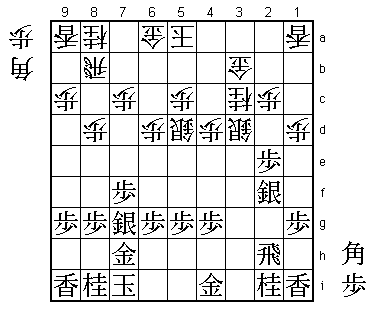
This is the new move that Maruyama prepared. The black plan is to move the silver
back to 3g and exchange the pawns on the second file, but 28.N3c prevents this
because the pawn on 2e can be taken. From this game it is hard to draw any conclusion
about the strength of 28.N3c, but it will be studied along with the alternatives
P4e, P6e, S5d-4e and G5b.
29.G4i-5h 00:43:00 00:07:00
30.P9c-9d 00:43:00 00:14:00
31.P5g-5f 00:48:00 00:14:00
32.S5d-4e 00:48:00 01:07:00
33.P5f-5e 00:57:00 01:07:00
34.P8d-8e 00:57:00 01:24:00
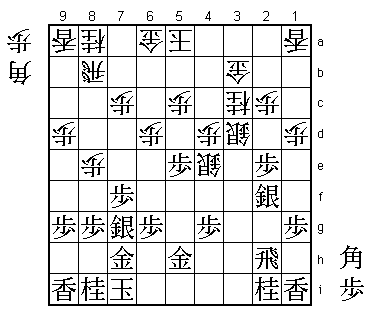
This move looks strange, because the most important reason for playing the Kakugawari
with tempo loss is to keep the pawn back on 8d, playing the knight to 8e instead.
However, Maruyama want to make a promoted bishop with B*3i followed by B8d+.
35.K7i-8h 01:10:00 01:24:00
Watanabe ignores the white threat of making a promoted bishop. If he wanted to
defend against it, 35.P6f seems to be the only way, but after 36.P9e black actually
has some trouble finding a good move. For example, 37.G5h-6g is answered by S3f
and Sx4g+ is hard to defend against. Also, 37.K8h is answered by 38.P8f and because
Sx8f is answered by B*3i, black has to take with the pawn, but after Px8f P*8e
Px8e N9c white has a nice attacking rhythm going.
36.P6d-6e? 01:10:00 02:30:00
A big mistake. Maruyama labeled it the losing move, even though we are still not
even close to sealing the move on the first day. Maruyama seemed to have been a
little psyched out by Watanabe's bold ignoring of the bishop promotion threat.
He said after the game that suddenly the black king formation looked so solid
that he decided against the bishop promotion. However, 36.P6e is based on a huge
miscalculation. White opens 6d for a bishop drop, which would be very strong, but
the hole is too big and black uses it first. Correct was 36.B*3i, which of course
was expected by Watanabe, who counted on the power 37.R3h B8d+ P5d Px5d B*5c.
However, after +B7d Bx4d+ P*3f he admitted that the position doesn't look so good
for black. For example, S3e G4c Sx3d Sx3d +B6f S*4i is a very painful drop.
37.P4g-4f 01:46:00 02:30:00
38.S4ex4f 01:46:00 02:33:00
Here Maruyama seemed to realize his mistake, as his hand clearly hesitated when
he played this move. However, it is too late.
39.B*6d! 01:53:00 02:33:00
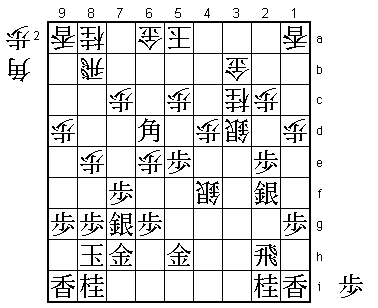
Black gets to 6d first. Why this is so important will become clear soon.
40.P8e-8f 01:53:00 03:13:00
41.P8gx8f 01:58:00 03:13:00
42.G6a-6b 01:58:00 03:27:00
43.P5e-5d 02:20:00 03:27:00
Threatens to promote the pawn and attacks the silver on 4f at the same time. We are
still on the first day, but the black advantage is already huge.
44.B*5e 02:20:00 03:29:00
45.B6dx5c+ 02:27:00 03:29:00
46.P7c-7d 02:27:00 03:33:00
47.R2h-3h 02:35:00 03:33:00
48.P*5b 02:35:00 03:42:00
49.+B5cx6b 03:01:00 03:42:00
50.K5ax6b 03:01:00 03:42:00
51.R3hx3d 03:01:00 03:42:00
52.P*8e 03:01:00 03:51:00
53.P8fx8e 03:42:00 03:51:00
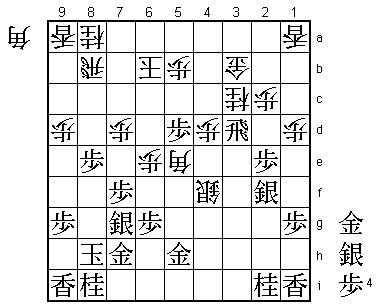
The sealed move. It was a surprise to the press room, where 53.P5c+ was analyzed.
Watanabe didn't like that after 54.Kx5c S*5f B7c the king could escape from the
center by K4c, attacking the rook at the same time. Watanabe said that he felt
he had a very good position here, but that he still felt that it was not completely
clear.
54.N8a-7c? 03:42:00 05:12:00
This forces an attack that white has no hope of pulling off. Watanabe expected 54.G4c,
and had prepared himself for a long battle after that. For example, 55.R3i B*2h R5i
Bx1i+ G5h-6h. Maruyama had of course looked at that, but he didn't like that this
forced black into an even stronger castle formation and that he saw no way to attack
it. Clearly, white's position is not good. He may have balanced the material, but
the difference in king position is significant.
55.S*5f 04:03:00 05:12:00
56.N7cx8e 04:03:00 05:17:00
57.P*8g 04:03:00 05:17:00
58.N8ex7g+ 04:03:00 06:14:00
59.N8ix7g 04:03:00 06:14:00
60.B5ex7g+ 04:03:00 06:21:00
61.G7hx7g 04:04:00 06:21:00
62.N*8e 04:04:00 06:22:00
63.G7g-7h 04:09:00 06:22:00
64.S*7g 04:09:00 06:24:00
65.G7hx7g 04:10:00 06:24:00
66.N8ex7g+ 04:10:00 06:24:00
67.K8hx7g 04:10:00 06:24:00
68.B*6i 04:10:00 06:25:00
69.G*7h 04:32:00 06:25:00
70.B6ix5h+ 04:32:00 06:35:00
71.N*8f 04:35:00 06:35:00
Resigns 04:35:00 06:59:00
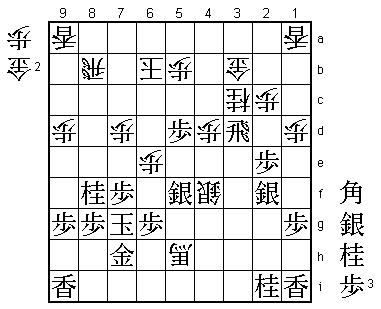
With the sun still high, Maruyama took 24 minutes to resign here. White's last
attacking plan was G*8e which threatens Gx7f next (Kx7f G*6f is mate), but this is
refuted by 71.N*8f because of the fork Nx7d. If white defends against this by G*6c
then black has no more defensive worries and just plays Rx4d. Maruyama saw no way to
continue his attack and resigned here. Watanabe called it a lucky win after the game,
because his opening position might have been suspect, but the quick disintegration of
the challenger is worrying for those who like a close match. Maruyama needs to win
game 2 with the black pieces, or he may prove to be just a small bump in the road for
Watanabe on his way to his eight consecutive Ryu-O title.




